|
|
RUGGEDBOOK SR858
Rugged convertible notebook with modern wide-format touchscreen display
(by Conrad H. Blickenstorfer, photography by Carol Cotton -- view PDF version)
Taiwan-based Samwell Group is a global technology solutions provider concentrating on the convergence of Internet, computing, and telecom technologies and software applications. "RUGGEDBOOK" is Samwell's brand name for their complete line of semi-rugged and fully rugged mobile computing products that include Tablet PCs, ultra-mobile PCs, and the SR858 rugged convertible notebook shown here. To the best of our knowledge, at the time of this review (August 2009) there aren't any other rugged convertible notebooks with a display this large and using the now common wide-format 16:10 aspect ratio display.
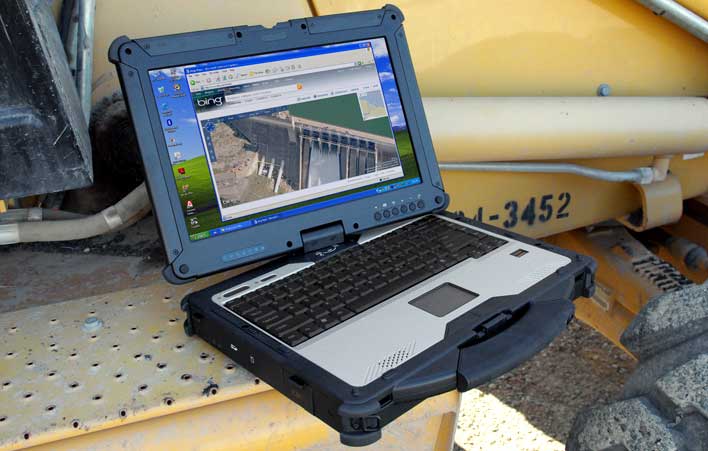
The RUGGEDBOOK SR858 is one of those notebook computers with a special centrally mounted display hinge that lets you rotate the screen so that the LCD side faces up and you can use the computer as a tablet. This adds a great deal of flexibility as the design allows operation in standard notebook mode as well as in Tablet PC mode.
The SR858 is a full-size notebook with a 13.5 x 9.7 inch footprint and a large 13.3-inch display. It's no lightweight at over eight pounds and it's more than two inches thick, but that's par for the course for this class of rugged machines. The display uses the "wide" 16:10 aspect ratio format that has pretty much become the new standard in notebooks. 1280 x 800 pixel WXGA resolution provides enough screen real estate for complex work, and the display is sunlight readable. A resistive touch screen comes standard with the machine, but there is no electromagnetic digitizer.
Ports, Expansion and Connectivity
Fully-rugged full-function notebooks like the SR858 are expected to have adequate onboard connectivity and expansion potential, and the SR858 delivers. Below are pictures of all four sides of the computer:
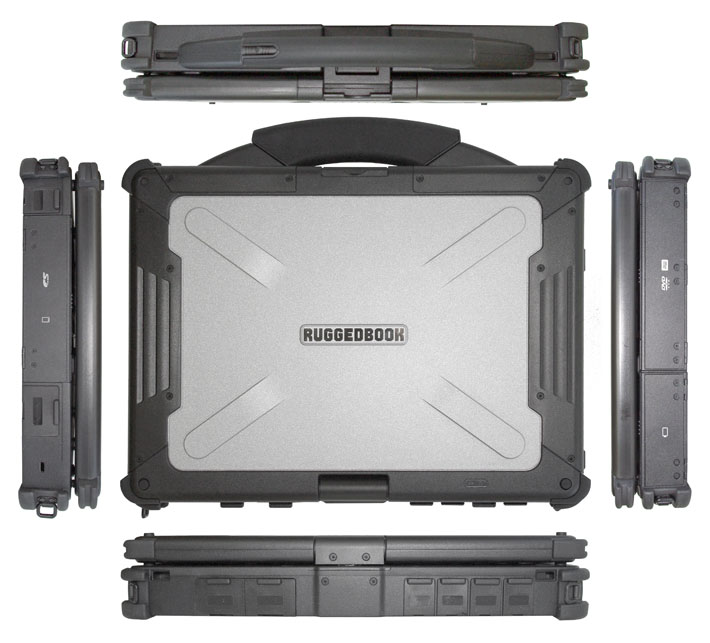
The top shows the front, which is free of any controls. There is a heavy-duty, spring-loaded handle with a rubberized surface that pulls out some when you carry the computer by the handle. The handle is nicely designed and may come in handy, but it's a bit too large and bulky for my taste. Underneath the handle is a metal clasp that secured the LCD both with the display side facing up or down.
The backside (shown below) has a number of ports that can all be individually sealed with hinged plastic/rubber plugs. The hinged plugs are secured to the computer with two small Philips screws each so they can easily be replaced. From left to right, there is VGA, RS-232 serial, two USB ports, RJ11 modem, RJ45 Ethernet, and a third USB port.

On the left side (shown below) are the SR858's two expansion slots, one PC Card Type II and one SD Card. Both are protected by a sturdy hinged plastic door. To the right of the cards compartment are jacks for headphones and a microphone. To the right of that is a Kensington security lock slot.
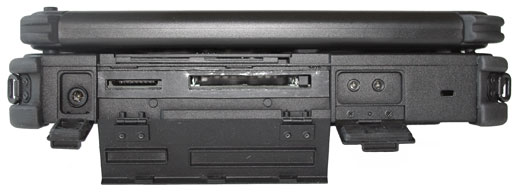
On the right side are the battery compartment and the media bay which in our machine accommodated a SuperMulti DVD-ROM drive. Both the battery and the drive bay compartments are behind hinged doors that are secured via single friction latches.
Under the Hood
The RUGGEDBOOK SR858 provides field access to user-replaceable modules. The picture below shows the machine with its bottom access cover removed.
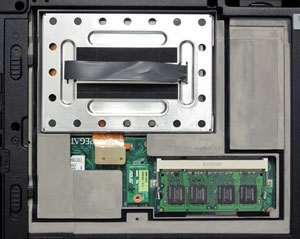 As you can see, everything fits neatly and tightly into compartments inside the very sturdy magnesium chassis. One of the two SODIMM memory slots is accessible once the cover is removed. As you can see, everything fits neatly and tightly into compartments inside the very sturdy magnesium chassis. One of the two SODIMM memory slots is accessible once the cover is removed.
The hard disk sits in its own heavily padded metal enclosure. It's a lightweight, sturdy box with extensive neoprene cushioning inside. The hard disk connection ribbon is a special design that includes a hard disk spindle heater. Why heating the spindle? Because that is the one area of a hard disk that is most likely to stick when it gets really cold. Heating the spindle lowers the permissible operating temperature of a hard disk considerably.
The disk in our review unit was a 250GB Seagate Momentus ST9250827AS 5400rpm drive with a 3Gb/second SATA interface that represents a good combination of capacity, durability and speed.
Not externally accessible are the various radio modules, those including 802.11a/b/g/n WiFI, Bluetooth 2.1 Class II + EDR, and a GPS receiver. Samwell also optionally offers WWAN (HSDPA/GPRS/GSM/CDMA).
Performance
Picking the right level of performance is a big challenge for contenders in the rugged full-size notebook field. These machines are big enough to accommodate the cooling and battery power necessary to run a high-performance chip, but speed always comes at a cost. Top-of-the-line notebook processors use several times the amount of power used by some of the more frugal chips, and leading edge processors can cost a bundle. This is where an educated compromise comes into play. Companies generally know their current and potential customers well enough to know what sort of applications they run and what sort of performance they expect. In addition, performance is not all about the processor. Disk, memory and graphic subsystems can make a big difference, as can the choice of operating system.
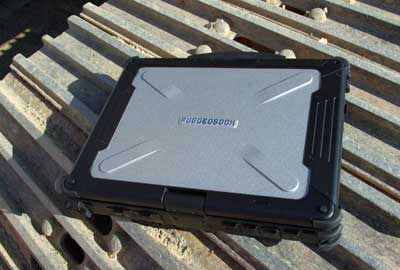 As a result, instead of using one of Intel's many hot-running high-performance processors, the RUGGEDBOOK SR858 comes with a power-efficient 1.06GHz Intel Core 2 Duo U7500. This chip has been around for a couple of years, and seen duty in such highly regarded machinery as Motion's LE1700 tablet. The U7500 is a 65-nanometer technology chip with 2MB of L2 cache that provides decent performance while sporting a low thermal design power of just 10 watts, less than a third that of standard notebook computer processors, and also considerably less than the direct competition from Getac, Panasonic and GD-Itronix. While the U7500 is a good chip, Samwell is taking a bit of a gamble here by heading for the starting line with less power under the hood. It's a gamble shared by a highly regarded pioneer of the rugged industry, DRS, formerly WalkAbout, banks on a lowly Core Solo processor in their ARMOR C12 notebook. As a result, instead of using one of Intel's many hot-running high-performance processors, the RUGGEDBOOK SR858 comes with a power-efficient 1.06GHz Intel Core 2 Duo U7500. This chip has been around for a couple of years, and seen duty in such highly regarded machinery as Motion's LE1700 tablet. The U7500 is a 65-nanometer technology chip with 2MB of L2 cache that provides decent performance while sporting a low thermal design power of just 10 watts, less than a third that of standard notebook computer processors, and also considerably less than the direct competition from Getac, Panasonic and GD-Itronix. While the U7500 is a good chip, Samwell is taking a bit of a gamble here by heading for the starting line with less power under the hood. It's a gamble shared by a highly regarded pioneer of the rugged industry, DRS, formerly WalkAbout, banks on a lowly Core Solo processor in their ARMOR C12 notebook.
We ran Passmark Software's PerformanceTest 6.1 that runs about 30 tests covering CPU, 2D graphics, 3D graphics, memory, and disk and then computes scores for each category and an overall PassMark score. For comparison, we included some of Samwell's direct competitors.
|
PERFORMANCE COMPARISON
|
RUGGEDBOOK
|
DRS ARMOR
|
GD-Itronix
|
Getac
|
|
Model
|
SR858
|
C12
|
GD8000
|
B300
|
|
Processor
|
Intel Core 2 Duo U7500
|
Intel Core Solo U1400
|
Intel Core 2 Duo SL9400
|
Intel Core 2 Duo L7500
|
|
CPU Speed
|
1.06GHz
|
1.20GHz
|
1.86GHz
|
1.60GHz
|
|
Thermal Design Power (TDP)
|
10.0 watts
|
5.5 watts
|
17.0 watts
|
17.0 watts
|
|
CPU Mark
|
608.0
|
329.4
|
1185.5
|
893.9
|
|
2D Graphics Mark
|
127.2
|
174.7
|
102.1
|
158.5
|
|
Memory Mark
|
216.9
|
251.4
|
559.0
|
400.0
|
|
Disk Mark
|
456.1
|
247.9
|
372.6
|
343.3
|
|
3D Graphics Mark
|
79.9
|
87.0
|
52.7
|
138.3
|
|
Overall PassMark
|
321.8
|
218.7
|
518.8
|
420.8
|
The benchmark figures simply show the relative performance of the very different processors. They also show that overall performance very much depends on the performance of subsystems (witness the SR858's speedy Seagate Momentus SATA disk). As is, the SR858's bottomline meets or exceeds that of almost all high-performance tablet slates, but it is no match for machines built to primarily run in vehicles where battery draw is no issue.
Power and Battery Life
Deciding on a balance between performance and battery life is always a challenge for notebook designers, especially for machines that will primarily be used where there are no power outlets. A rugged notebook like the SR858 will often have to rely on onboard power, and Samwell therefore equipped it with a high-capacity battery. 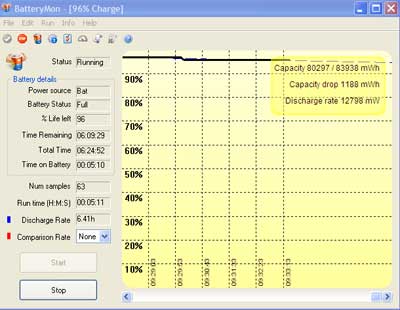 The standard battery is a powerful 11.1 Volt, 7,800 mAH (86 watt-hour) Li-Ion pack that glides into the right side of the machine where it is securely held in place and protected behind by a door with a friction lever. While the SR858 has a media bay, there does not appear to be an option for a secondary battery in place of the standard SuperMulti DVD-ROM. The standard battery is a powerful 11.1 Volt, 7,800 mAH (86 watt-hour) Li-Ion pack that glides into the right side of the machine where it is securely held in place and protected behind by a door with a friction lever. While the SR858 has a media bay, there does not appear to be an option for a secondary battery in place of the standard SuperMulti DVD-ROM.
But how long does the large battery last? We ran our standard BatteryMon drawdown benchmarks to determine power draw and projected battery life. We set backlight to its lowest setting, turned off all the radios, and set the machine to "max battery" mode. With those settings, the idle discharge rate was as low as 12.8 watts, which translates into a theoretical battery life of almost seven hours. That, of course, varies with the way the computer is used. The power draw is about what we expected from this setup and processor.
Samwell claims five+ hours with the standard battery, and based on the observed draw, that ought to be possible. With WiFi and Bluetooth on and the backlight set to its brightest position, battery draw climbs to 18-19 watts, and that would still translate into about five hours.
Display Technology
A good balance between performance and battery life make the RUGGEDBOOK SR858 an efficient tool for work in the field, but there is one other essential requirement for a modern rugged computer: a daylight/sunlight readable display. 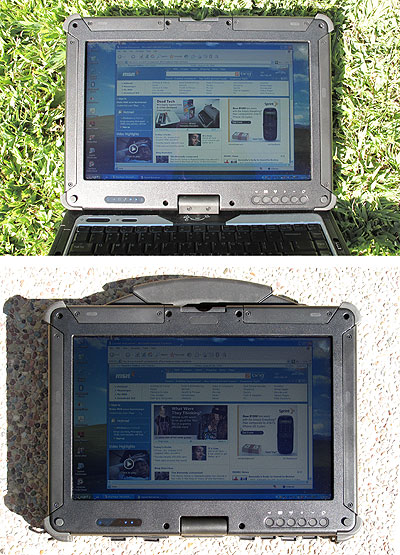 Over the past two decades, manufacturers of rugged computers have tried various technologies designed to improve outdoor viewability. Standard transmissive displays wash out outdoors and even strong backlights are no match for daylight and the sun. Reflective displays work great in the sun, but they look "flat" and are nearly unusable indoors. Transflective displays combine the two technologies, but are an unsatisfying compromise. Over the past few years, almost everyone has switched to a variety of optical treatments, including filters and polarizers, to facilitate outdoor viewability. Clever use of optics and physics is employed to minimize reflection while preserving contrast. These methods can result in amazingly good viewability under almost all lighting conditions. While in the past, working outdoors with a notebook computer meant searching for a shady spot where you could actually see the screen well enough to work, this should no longer be a problem with a modern rugged computer. Over the past two decades, manufacturers of rugged computers have tried various technologies designed to improve outdoor viewability. Standard transmissive displays wash out outdoors and even strong backlights are no match for daylight and the sun. Reflective displays work great in the sun, but they look "flat" and are nearly unusable indoors. Transflective displays combine the two technologies, but are an unsatisfying compromise. Over the past few years, almost everyone has switched to a variety of optical treatments, including filters and polarizers, to facilitate outdoor viewability. Clever use of optics and physics is employed to minimize reflection while preserving contrast. These methods can result in amazingly good viewability under almost all lighting conditions. While in the past, working outdoors with a notebook computer meant searching for a shady spot where you could actually see the screen well enough to work, this should no longer be a problem with a modern rugged computer.
The pictures to the right show how well the SR858's display performs in direct sunlight. The unretouched pictures, taken with a 14.5-megapixel Canon G10 digital camera, show the SR858 facing the California mid-day sun. This is a remarkable accomplishment. I am not sure of the exact composition of the display's layers, filters and bonding technologies, but they certainly work. While the filters and coatings all come from a small number of highly specialized vendors, the way they are bonded and layered can make a huge difference, and the manufacturing technologies are closely guarded secrets. As is, the screen Samwell uses for the SR858 does not wash out and remains clearly visible, with excellent contrast. That's especially remarkable for a touch screen with its additional layers (and therefore additional surfaces that need to be bonded or treated).
Nothing is perfect, though. The SR858's yielding touch screen surface is smudge and fingerprint-prone. Since it is not totally flat like a plate of glass, there are some optical distortions in the reflections, especially around the perimeter. And since this is a "gloss" screen, there can be annoying reflections and you often find yourself positioning the computer to minimize that effect.
Comparison: Samwell Technology Versus Conventional Display
The first picture below compares the RUGGEDBOOK SR858 display with that of an older Tablet PC display (a 2002 vintage Toshiba Portege 3500). The two displays were set up in bright noon daylight, mid August, in a shaded location. The SR858 display is perfectly readable without any visible reflections on its glossy surface. The older display's anti-glare coating also shows almost no reflections, but the anti-glare coating diffuses the light and turns the display milky and almost unreadable.
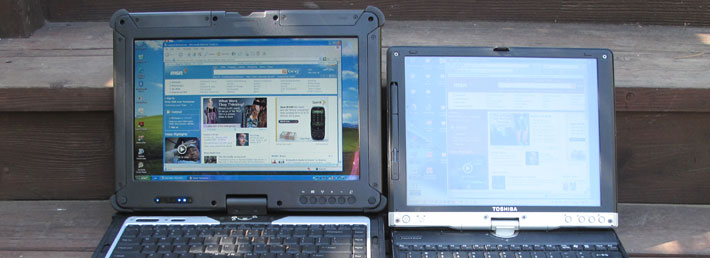
In the picture below, the two machines are in the same location, but the image was taken from an angle. The SR858's display remains very readable with just a bit of reflection from its surroundings. The older display's matte surface diffuses the light so much that the screen becomes unreadable.
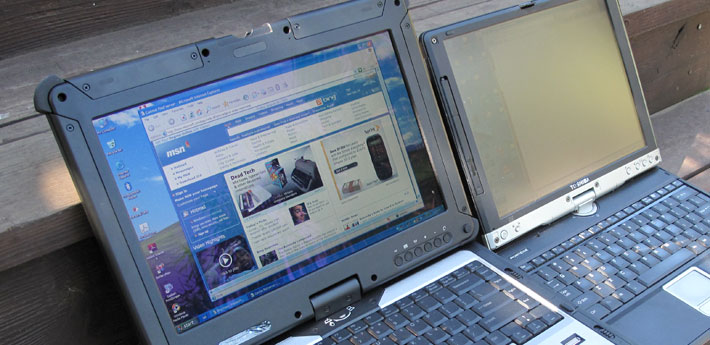
Photographed from the right side, the SR858's glossy display surface shows reflections from the trees next to it. This a price you pay with almost all "glossy" display surfaces that make for a bright, contrasty picture that "pops," but are also prone to showing reflections. The older display's anti-glare display doesn't have reflections and remains readable, though just barely.
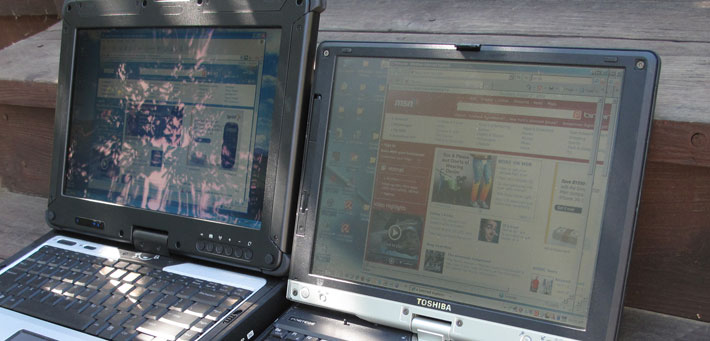
Overall. Samwell's outdoor-viewable technology is impressive. At times you have to position the notebook to stay clear of reflections, but there is always enough contrast and brightness to use the computer outdoors, under any lighting conditions.
Touch Screen Control
Our RUGGEDBOOK SR858 came with a resistive touch screen that can be operated either with a plastic stylus or with a finger. The resistive touch panel controller communicates with the processor via a USB connection and is very quick and responsive. The machine comes with a special Touchkit touch screen utility control panel for adjusting, calibrating and optimizing the screen for accurate touch performance, ease of use, and special configurations. The image below shows four of the utility's seven panels.

Here are some of the features of the touch screen utility:
- Setting lets you set linearization either to nine or 25 points, with 25 points offering maximum accuracy. You can also set double click time and area, beeps, auto right click, cursor stabilization, and five different mouse modes (like click on touch, click on release and so on) according to personal preference. If you intend to use the computer primarily with finger touch, you can set it so that the driver stops reporting points when movement is within a pre-defined range. This way the cursor will not jitter around when the same point is touched again or when you move a pen within a small area.
- Tools (second screen in above picture) shows a linearization curve, lets you verify touch accuracy, and lets you set and clear linearization parameters.
- Display (third screen in above picture) lets you map the touch screen in various ways. You can enable multiple displays and you can also map the touch screen to only part of the display. There may be applications where it comes in handy to have only the bottom part respond to touch, and the SR858 lets you do that. You can even create a customized area anywhere on the display and set it so only that area responds to touch. This is ideal for custom software applications.
- Edge Compensation (right screen in above picture) can be very valuable for those who use the stylus a lot. With touch screens and digitizers it's often difficult to touch or select items at the edge of the panel, and especially so when the LCD display runs all the way to the kind of thick protective bezel some rugged computers have. The SR858 touch panel allows you to precisely define edge compensation for all four sides, i.e., set it so the cursor thinks the edge is either farther away or closer in. Precise configuration can make for optimal usability and responsiveness in touch applications.
- Hardware makes the system read the touch screen hardware parameters. After it's done, you can then change the sensitivity and delay time.
Keyboard and touchpad
The RUGGEDBOOK SR858 has an 86-key keyboard. The QWERTY layout is full-size. The keys are black and have fairly faint lighter colored labels. The labels are semi-transparent so they light up in blue when the keyboard backlight is turned on via a button above the keyboard. The illumination works well, but the fairly bright blue LEDs underneath can be distracting when you look at the keyboard from an angle (they shine through the gaps between the keys). The keys provide good tactile feedback and it's easy to type on the SR858.
I was not a fan of the small recessed 2.25 x 1.6 inch touchpad. I found it imprecise and hard to operate with my finger. It works great with a stylus, but a touchpad should work well with a finger.
Tablet Mode and the Windows XP Tablet PC Edition
One of the special talents of the SR858 is that you can rotate the display case and then fold it down onto the keyboard with the LCD display facing up. This turns the SR858 into a tablet computer, albeit a rather heavy one. In tablet mode you don't have access to the physical keyboard, and so Samwell added a number of buttons that allow: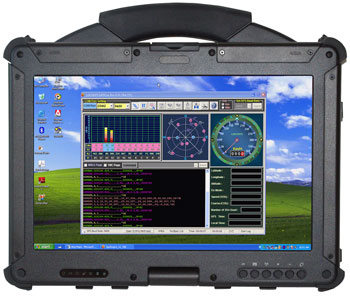
- screen rotation in 90 degree increments
- brightness up and down
- turning radios on and off
- bring up the onscreen input panel/onscreen keyboard
- bring up the Windows Task Manager
Now, how can you take advantage of the tablet mode? In this day and age of competing versions of Microsoft operating systems and the increasing integration of pen and touch functionality into main body of an OS, picking the right OS for a touch and pen-enabled system is a challenge. For the SR858, Samwell chose the Windows XP Tablet PC Edition. This is a special version of Windows XP whose origins go all the way back to Microsoft's unveiling of the Tablet PC platform in December of 2002. Like XP itself, the Tablet PC Version received some updates. Under Vista and in Windows 7, there are no separate versions for pen and touch functionality.
As is, the Tablet PC Edition includes a variety of pen-centric functions, utilities and applications. There's a special input panel that can work both as an onscreen keyboard or for handwriting recognition for when you use the SR858 as a tablet (see screen captures of all three modes below). There's Windows Journal (a fairly powerful ink processor), Sticky Notes, pen tutorials and Microsoft also offers all sorts of very useful utilities and helper apps. Problem is, the Tablet PC Edition was really designed for use with an active digitizer. Touchscreen systems do work with the Tablet PC Edition, but they are far from optimal for the special pen functionality designed into the Tablet PC Edition. With an active digitizer, ink goes on quickly and smoothly and the pressure of your hand or palm onto the screen is no issue. With a touchscreen it is, and it makes Journal and other pen applications pretty much useless. That's why a lot of slates come with both a digitizer and a touchscreen. It'd be nice to have both in the R858 as well.
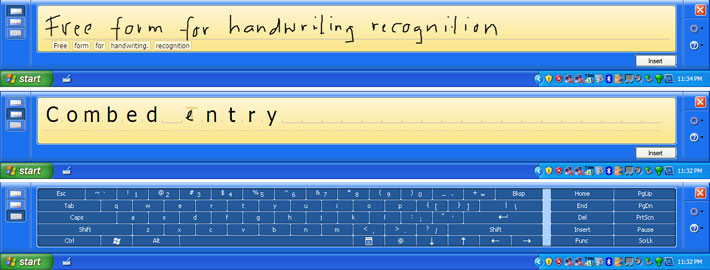
As is, the Tablet Edition is Windows XP, and that remains a very good choice for a machine that needs maximum responsiveness and speed from relatively modest hardware. In that, the SR858 succeeds. It is quick and responsive.
Security
Like almost all modern computers, the RUGGEDBOOK SR858 offers several physical and software security measures. There is a swipe style solid-state fingerprint reader located below the keyboard on the right side. Biometric fingerprint scanning is very effective and can be used to complement, reduce or eliminate multiple passwords.
As part of its security, the SR858 also uses Trusted Platform Module (TPM) hardware. The TPM 1.2 micro controller with cryptographic functionality allows you create and manage computer-generated digital certificates. Combined with software, these certificates can be used to:
- Send and received secure email,
- Set up the browser for client identification,
- Sign Word macros,
- Encrypt individual files or entire folders, and
- Create secure network connections.
To use TPM, you have to enable TPM support in the BIOS and then configure the system with the supplied Infineon Security Platform Settings Tool (shown below).
The Infineon setting tool is a wizard that guides you through the entire process from initial user settings where you set your basic password, configure secure email and encryption, and manage certificates; to making backups of all the security settings, secure drives, and credentials; to migration of security credentials from one platform to another; password resets; and advanced topics like owner passwords, enhanced authentication, emergency recovery, and system and user-specific security policies.
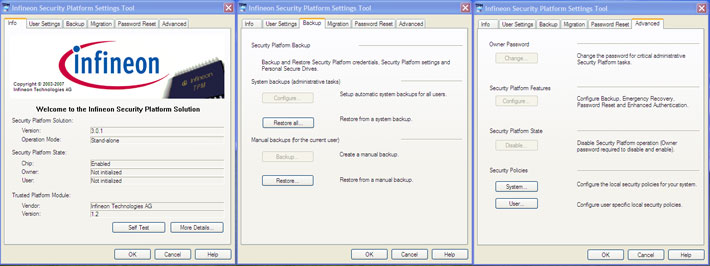
Setting up all this security can get pretty complicated. Some users may never implement TPM or even passwords, whereas others may configure their systems in accordance with company IT security procedures, or they may configure an individual system for maximum security.
In addition to software measures, don't forget physical security and get a Kensington locking cable to use with the Kensington slot on the left side of the unit. It is inexpensive insurance against having your computer stolen.
Ruggedness and Protection
The SR858 is a very rugged platform with a sturdy magnesium alloy housing and ample protection both inside the unit (via shock mounting) and outside (via rubber bumpers and impact and scratch-resistant materials and surface treatment. Samwell successfully tested the SR858 per MIL-STD-810F for drops, temperature, thermal shock, vibration, humidity and altitude, and also claims IP65 level sealing, where the "6" means the device is totally dustproof, and the "5" that it can handle low-pressure water jets from all directions.
Almost all ports are individually sealed so that using one of them does not expose others. Protective doors can easily be replaced should they get damaged.
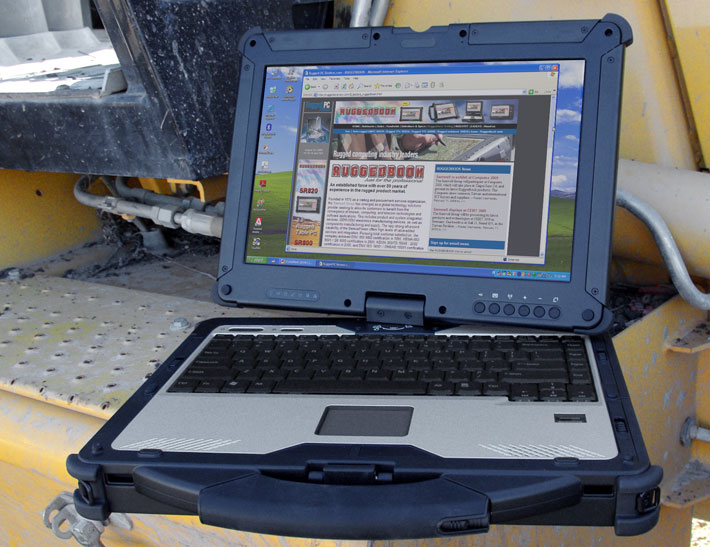
Summary
The Samwell RUGGEDBOOK SR858 is a fully-rugged 8.25-pound convertible notebook computer that offers a good balance of size, weight, performance and battery life. Thanks to its swivel hinge, the display can be flipped around so that the computer becomes a tablet. This provides additional flexibility and versatility.
The RUGGEDBOOK SR858 has a spacious 13.3-inch touch screen with 1280 x 800 pixel resolution in the wide-format 16:10 aspect ratio. The screen is bright and provides excellent outdoor and even direct sunlight readability. The lack of an electromagnetic digitizer curtails tablet use to some extent, and so some of the attractive features of the unit's Windows XP Tablet PC Edition operating environment cannot be used to full potential.
An integrated optical drive, excellent onboard connectivity, PC Card and SD Card slots, and a large hard disk make the SR858 a competent all-around performer. The unit's Intel Core 2 Duo U7500 processor is both energy-efficient and quick enough for almost all tasks.
In terms of ruggedness, the SR858 has a very wide operating temperature range, offers very good physical protection, and is sealed to IP65 specifications. Rubber bumpers on all corners keep scratches at a minimum and provide extra protection.
The RUGGEDBOOK SR858 is unique in that it offers the rugged convertible notebook form factor with a larger display than any of the competition. It is therefore a good solution for tasks that require both notebook and tablet functionality, Core 2 Duo performance, long battery life and more screen real estate than is commonly available in rugged tablets.
RUGGEDBOOK SR858 highlights:
- Fully-rugged compact notebook for use in just about any application and setting anywhere
- Rotating screen hinge allows operation as notebook and as tablet
- A new competitor for rugged notebooks from Panasonic, General Dynamics, Getac, etc.
- Good balance of performance and battery life
- Large 13.3-inch 1280 x 800 pixel display in the now common wide-format 16:10 aspect ratio
- Excellent outdoor-viewable display quality
- Quiet operation, barely heats up at all
- Elegant and durable industrial design
- Very good security via multiple access protection technologies
But keep in mind:
- Display has narrow vertical viewing angle
- Touch screen only; no active digitizer
- Small, recessed touchpad hard to operate
- Integrated carry handle large and bulky
– Conrad H. Blickenstorfer, August 2009
|
RUGGEDBOOK SR858 Specifications
|
| Added/changed |
Added 4/2009; full review 8/2009
|
| Type |
Rugged notebook
|
| Processor |
Intel Core 2 Duo U7500 w/ 533MHz frontside bus and 2MB L2 cache |
| Thermal Design Power |
10 watts |
| OS |
Windows XP Tablet PC Edition, Windows 7 Professional |
| Graphics Controller/Chipset |
Mobile Intel 965GM integrated graphics |
| Memory |
1GB/4GB DDR2 in two SO-DIMM slots |
| Display |
13.3-inch/WXGA (1280 x 800 pixel) wide format sunlight-readable TFT |
| Digitizer/Pens |
Resistive touch screen/1 |
| Keyboard |
Backlit 87-key 100%-scale, waterproof |
| Storage |
Shock-mounted 2.5-inch 250GB 5400rpm SATA hard drive |
| Multimedia Pocket |
Standard: SuperMulti DVD-ROM |
| Slots |
1 PC Card Type I/II, 1 SD Card, 1 SIM |
| Housing |
Magnesium alloy |
| Temperature |
-4 to 122F |
| Humidity |
MIL-STD 810F Method 507.4, 5%-95% non-condensing |
| Vibration |
MIL-STD-810F, Method 514.5, Procedure I |
| Hinge Endurance |
unknown |
| Outdoor viewability |
unknown |
| Enclosure Class |
IP65 |
| Shock |
MIL-STD-810F, Method 516.5, Procedure IV |
| Mechanical shock |
MIL-STD-810F, Method 516.5, Procedure I (sawtooth pulse 40G for 11ms, total 18 shocks) |
| Altitude |
MIL-STD-810F, Method 500.4, Procedure II (15,000 feet, 1 hr) |
| Size (inches) |
13.5" x 9.7" x 2.3" |
| Weight |
8.25 lbs. as tested (incl. battery, optical drive and handle)
|
| Power |
Li-Ion 11.1V/7,800mAH 86 watt-hour ("5+ hrs in normal use") |
| Communication |
802.11a/b/g/n, Bluetooth Class 2 v 2.1 with EDR, GPS; optional WWAN (GSM/GPRS/HSDPA/WCDMA) |
| Interface |
3 USB 2.0, gigabit RJ-45, RJ-11, VGA, RS232 serial, audio in/out, dock, fingerprint biometrics reader |
| Price |
Inquire |
| Spec sheet |
SR858 official specsheet |
| Contact |
www.ruggedbook.com.tw or info@ruggedbook.com.tw |
|
|



